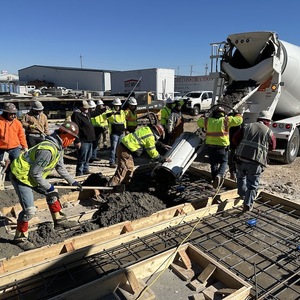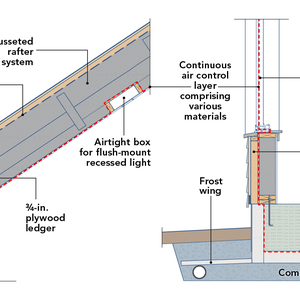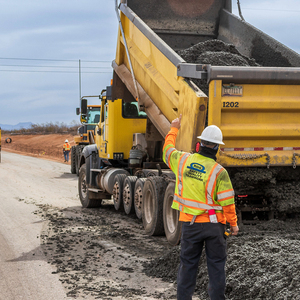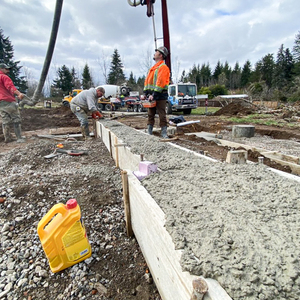
A new study examines the “remaining carbon budget” (RCB), which is the amount of CO2 that can still be added to the atmosphere without exceeding global warming temperature targets. The authors describe the remaining budget as “tiny” and call the situation “dire.” To have a 50% chance of staying under 1.5 degrees Celsius the budget or ceiling is down to 250 gigatonnes of CO2. The United Nations Environment Programme’s Emissions Gap report says, “Only an urgent system-wide transformation can deliver the enormous cuts needed to limit greenhouse gas emissions by 2030: 45% compared with projections based on policies currently in place to get on track to 1.5°C and 30 percent for 2°C.”
Construction is a major contributor to carbon emissions, much of it coming from the use of concrete. In their Emissions of Materials Benchmark Assessment for Residential Construction (EMBARC) study, Builders for Climate Action and Passive Buildings Canada examined 503 Canadian houses and found that concrete, mostly in foundations and slabs, comprised 33% of the Material Carbon Emissions (MCE), the “cradle to gate” portion of upfront carbon; a third of carbon emissions could be eliminated if alternative foundations and slabs were used. This is probably an underestimate of the full impact of concrete; Builders for Climate Action and Paasive Buildings Canada use MCE because the data on transportation and on-site construction—from gate to completion—are so variable. But concrete is heavy, and just moving it has a big footprint.
To dig or not to dig
Concrete foundations are the de facto standard in North America but they have many problems besides their carbon footprint; they have little insulation value, they crack, they leak, and they are not even fireproof. Sustained temperatures above 570°F reduces concrete’s strength and can cause cracking or bowing. After the 2021 Marshall Fire in Colorado, many of the foundations were too…
Weekly Newsletter
Get building science and energy efficiency advice, plus special offers, in your inbox.

This article is only available to GBA Prime Members
Sign up for a free trial and get instant access to this article as well as GBA’s complete library of premium articles and construction details.
Start Free TrialAlready a member? Log in















16 Comments
We have been building on wood pilings at the Jersey shore for 60 years, and probably a million homes from Maine to Texas have been built this way on the coast. Easy, cheap and reliable, better than masonry in flood zones (less resistance to moving water and absorbs less pollutants from flood waters). A foundation can be laid out and completed in less than a day with zero concrete or cement. And contrary to popular belief, huge luxury homes and commercial buildings can be built this way. My next door neighbors home built entirely on wood pilings is 10,000 feet and is high end in every way, including $$$$$.
Nick,
In the early 80's coastal BC had an interesting fish cannery architectural aesthetic that became the basis of the very popular Grandville Island in Vancouver, and a dockside development in nearby Steveton. Building on piles was a big part of that. I wish it had caught on more widely.
Any details for a garage built on these approaches? Or is slab on grade the only option? Just thinking residential garage.
jameshowison,
Lot's of garages and large storage buildings on farms have been built without foundations for literally centuries. If you are content with compacted road-base as a finished surface, the process is a lot easier than it is for a house.
If you don't do much/any work on your own cars, any surface capable of supporting the weight of a car will work. If you do work on your own cars, you need to have a safe and stable base to support jackstands, jacks, etc.
At the more extreme end for a home shop, a 2-post lift needs footings with compression and bending load distribution, and a 4-post lift needs compressive strength. That's hard to do without concrete.
You could make a garage with a raised timber floor capable of bearing vehicle weight, as was common for barns, old timey auto shops, and train buildings. I've seen some old pics from Europe of oil-soaked heavy timber floors inside hillside service garages, with walkout storage or shop space underneath. Seemed to work fine for old Ferraris in Italy, and makes for wonderful photography.
No idea if that is a practical solution nowadays or what the code implications are. You're basically making a wooden trailer deck as the floor of a building, more or less. Or an industrial mezzanine, as another way of thinking about it.
Good article, but I wanted Lloyd to talk more about more traditional-style concrete-free (or concrete-lite) "pin" foundations. I am just about directly on bedrock and want to go this route, but even the pin foundations I've seen (like this JLC example from a few years ago: https://www.jlconline.com/how-to/foundations/pinning-to-ledge_o) use quite a lot of concrete. What is a good pier-n-beam w/pins assembly? Could I simply make the pins the centerpiece of mortared stone piers? Thanks for any ideas or insight.
dack,
I've built a couple of houses directly on rock, much like the one in the JLC article. You get to omit the footing, but drilling in the pins and contouring the bottom of the stem-walls makes them more labour intensive than if they were on soil.
Pinning piers to rock I've done two ways. One was quite similar to the full foundation in that you epoxy pins into the ledge, then build concrete piers above. I've done that on an ADU, and also used a variation of that for the bridge I've attached.
The other I've only used on decks, and would definitely need engineering to size the pins, but you end up with a concrete-free foundation similar to helical piers. I drilled holes in the ledge deep enough to provide horizontal resistance, epoxied in 1" threaded rod, and supported the beams on large square washers and nuts.
One complication with building with piers on rock is that in most climates you not only have to make a chase for the services from the underside of the floor to grade (as you do with any house on piers), but also somehow keep those services from freezing on the rock until they get somewhere they can be buried.
Fantastic response. Thanks Malcolm. I had not fully considered the chase issue. My situation is nowhere as extreme as your photos (super cool, BTW). There is some soil on top of the bedrock. I wonder if it might make more sense to add fill and screw in helical piers 'til they hit bedrock. Anyhow, thanks for the input.
dack,
It was a pretty nice spot to spend a couple of weeks working. Dropping tools was annoying when the tide was in.
I've been looking into pin foundations. A small house foundation using a pin-frame or pin-pile foundation capable of supporting the necessary loads would use 600 to 1000 linear feet of 2" schedule 40 6061 aluminum pins, plus several hundred pounds of hot dipped galvanized steel or aluminum for the heads. Is this really a carbon savings over using pre cast concrete piers? There would be carbon savings for having less excavation and concrete, but that's a lot of carbon intensive galvanized steel and aluminum to make up for.
To clarify, I'm strictly discussing carbon impact. Pin foundations have a great many other benefits, just maybe not upfront carbon.
Both steel and Portland cement release somewhere around 1-2 pounds of CO2 for every pound of finished product. Every pound of aluminum used releases 4-20 pounds of CO2 emissions.
According to the BEAM tool (https://www.buildersforclimateaction.org/beam-estimator.html), a 10" round concrete pier has 11 pounds of CO2 emissions per foot. Piers should have rebar; one #5 vertical rebar adds a little over 1 pound of CO2 for a total of 12 lbs CO2/ft of pier, not including footings or additional reinforcement.
The BEAM tool shows that each foot of 3" galvanized steel helical pier has 11 pounds of CO2 emissions.
In other words, at first glance, there is not a big difference between using a typical concrete pier and a typical helical pier, in terms of actual material used. The difference is in the labor, both human and machine, to install them. When specifying piers on my projects I usually offer the option of concrete or helical piers.
I have not seen or used aluminum pin foundations; assuming they are something like a steel helical pile, they would have more carbon impact than concrete piers.
Thanks Michael.
Nice to hear confirmation from the BEAM tool.
I've done quite a bit of building on islands in Midcoast Maine where all machines and materials need to be transported by barge or ferry. Pin foundations would have great benefit over excavated holes with concrete piers or even helical piers. I wonder though how the pins would drive through the rock and boulder filled soil. I might find an excuse to drive a few test pins on a project just out of curiosity.
I would not want a house bearing on aluminum continuously exposed to salt air. I would consider stainless steel, but on coastal projects I think concrete is the durable choice. I've done projects on Vinalhaven, Chebeague, Peak's and Great Diamond, and I worked for three years on Nantucket, so I know the drill!
I am curious what your customers choose most often. I assume helical piers due to the labor difference?
“[Deleted]”
Missed your reply Michael. I agree on the aluminum. Hot dip galvanized perhaps, but for a house I think I'd opt for stainless in that climate and clay soil.
My company is fabricating some pin piers from 304 stainless for a small boardwalk project on North Haven to be installed this summer. Kind of a test case with a structural engineer to see how the stability is, and if we can drive the pins through the rocky soil on the island.
We may use a similar design to inexpensively stabilize banks that are being washed away with sea level rise and recent storm surge on the island. Scary and sad time for coastal towns.
I'll post how it goes.
Log in or become a member to post a comment.
Sign up Log in